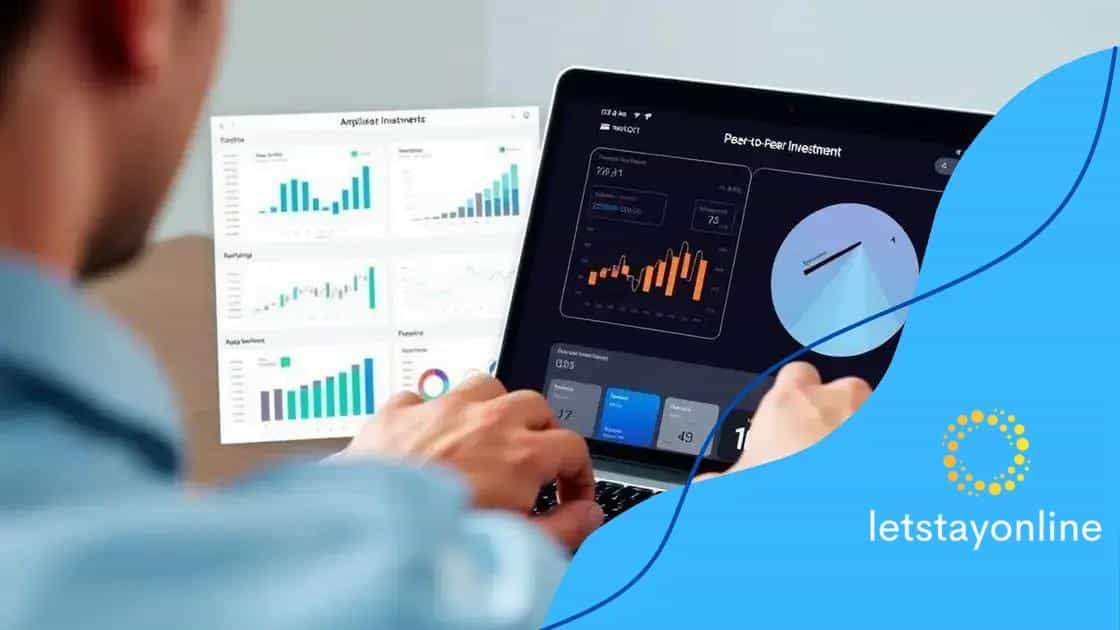Pros and cons of using peer-to-peer investment platforms

Peer-to-peer investment platforms provide opportunities for individuals to lend money directly to borrowers, offering higher returns and access to diverse investment options, but they also carry risks such as borrower defaults and less regulatory oversight.
Pros and cons of using peer-to-peer investment platforms are crucial for anyone considering this investment avenue. Have you ever thought about how these platforms could shape your financial future? Let’s dig deeper into what they offer.
Understanding peer-to-peer investment platforms
Understanding peer-to-peer investment platforms is essential for anyone looking to venture into modern investment opportunities. These platforms connect investors directly with borrowers, often bypassing traditional financial institutions. This interaction creates unique opportunities and risks.
What are Peer-to-Peer Investment Platforms?
Peer-to-peer (P2P) investment platforms allow individuals to invest their money directly into loans or projects. This setup promotes a more democratic form of lending and investing, enabling more people to participate in the financial ecosystem.
Benefits of Using P2P Platforms
- Higher returns: Investors may earn higher interest rates than traditional savings accounts.
- Diverse portfolios: These platforms often allow investments in various loans, helping to spread out risk.
- Accessibility: Individuals can invest with smaller amounts of money, opening doors for new investors.
Investors can also benefit from the ease of use these platforms offer. Many have user-friendly interfaces and provide straightforward processes for browsing loan requests. As a result, investing becomes accessible even for those who may not have extensive financial backgrounds.
Risks to Consider
- Default risk: Borrowers may not repay their loans, resulting in potential losses for investors.
- Less regulation: P2P platforms are not always subject to the same regulations as banks, which can lead to uncertainties.
- Market risks: Economic downturns can affect the stability of these investments.
Understanding these risks is just as important as recognizing the benefits. Being aware of potential challenges can help investors make informed decisions.
Additionally, some platforms may charge fees that could cut into overall returns. It’s crucial to compare various P2P investment options, as fees, interest rates, and platform ratings can differ widely among services.
In summary, peer-to-peer investment platforms represent a fascinating evolution in the investment landscape. They empower individuals and cultivate financial independence while also introducing unique risks, which investors must navigate carefully.
Advantages of peer-to-peer investing

The advantages of peer-to-peer investing are attractive for many individuals looking to grow their wealth. These platforms provide opportunities that traditional investment methods might not, making them appealing for both seasoned and new investors.
Higher Potential Returns
One of the primary advantages is the potential for higher returns compared to conventional investments like savings accounts or CDs. P2P platforms often allow investors to earn interest rates that can be significantly higher, which is appealing for those seeking to maximize their profits.
Investment Diversification
Diversifying investments is key to reducing overall risk. P2P investing enables individuals to allocate their funds across various loans and borrowers. This variety helps spread out the risk, as not all loans will default at the same time.
- Low minimum investments: Many P2P platforms have low minimum investment requirements, allowing more people to participate in this investment type.
- Easy access to information: Investors can easily view borrower profiles and loan types, promoting informed decision-making.
- Community impact: By investing in local projects or small businesses, individuals can contribute to their community’s growth.
Engaging in P2P investments also creates a sense of community participation. Many investors enjoy the idea that their money is helping individuals or businesses achieve their goals.
These platforms typically offer user-friendly interfaces, making it easier for investors to navigate through options and manage their portfolios. As a result, individuals can quickly adapt to changing market conditions, staying informed and making strategic choices.
Overall, the advantages of peer-to-peer investing present compelling opportunities for those eager to make their money work for them. With the benefits of higher returns and increased engagement in local projects, investing through P2P platforms could be a game-changer for many.
Disadvantages and risks involved
While exploring the disadvantages and risks involved in peer-to-peer investing is crucial, many investors may overlook them. Understanding these challenges helps individuals make informed decisions about their investments.
Default Risk
A significant risk in P2P investing is the potential for borrowers to default on their loans. If a borrower fails to repay, investors may lose part or all of their investment. It’s essential for investors to consider the likelihood of defaults when choosing where to allocate their funds.
Less Regulation
P2P platforms are generally less regulated than traditional banks. This can create an environment where investors have less protection. If a platform fails or faces financial issues, investors may have a limited recourse to retrieve their funds.
- Limited transparency: Sometimes, borrowers’ credit information may not be fully disclosed, making it difficult to assess their creditworthiness.
- Market fluctuations: Economic downturns can impact borrowers’ ability to repay loans, increasing default rates.
- Platform reliability: The stability of a P2P platform can affect investments, as some may not survive in competitive markets.
Another aspect to consider is the lack of liquidity. Once you invest your money in a loan through a P2P platform, it could be tied up for a long time. This means you may not be able to access your funds until the borrower repays the loan, which may take several months or years.
Investors should also be aware of fees that some platforms charge. These fees can cut into your overall returns, diminishing the appeal of high interest rates. It’s important to read the fine print and understand all costs involved before committing.
By recognizing the disadvantages and risks involved, investors can better navigate the challenges of P2P investing and make choices that suit their financial goals.
How to choose the right platform

Choosing the right platform for peer-to-peer investing is crucial for maximizing returns and minimizing risks. Several factors can affect your decision, and understanding them helps you navigate this investment space.
Evaluate Platform Reputation
One of the first steps is evaluating the reputation of various P2P platforms. Look for reviews and testimonials from other investors. Reliable platforms usually have a history of successful loans and satisfied users.
- Check ratings: Use websites that rate financial tools to compare different platforms.
- Look for transparency: Trustworthy platforms openly share their fees and terms.
- Review customer support: Assess how easy it is to get help if needed.
Another crucial factor is examining the types of loans available. Different platforms specialize in various loan types, such as personal loans, business loans, or real estate. Determine which type aligns with your investment goals. Investing in loans you understand can enhance your chances of making informed decisions.
Understand the Fees Involved
Before deciding on a platform, it’s important to understand the fees associated with it. P2P investing platforms may charge various fees that could eat into your profits.
- Origination fees: Some platforms charge a fee for processing the loan application.
- Service fees: Look for annual service fees that could impact your overall returns.
- Withdrawal fees: Check if there are fees for withdrawing your funds later.
Understanding these fees helps you make an informed choice and select a platform that offers the best value for your money.
Risk assessment is another significant aspect of choosing a platform. Be sure to review the risk grading system of the loans offered. Platforms often rate borrowers based on creditworthiness, and this grading can help you decide which loans to invest in based on your risk tolerance.
By carefully considering these factors, you can confidently choose the right peer-to-peer investment platform that aligns with your financial goals and comfort level.
Future trends in peer-to-peer investments
The future trends in peer-to-peer investments are shaping how individuals and businesses approach financing and investing. As technology evolves, these platforms are becoming more accessible and user-friendly.
Emergence of New Platforms
With the popularity of P2P investing, more platforms are entering the market. These new players often introduce innovative features, making it easier for users to invest. This competition can lead to better services and lower fees for investors.
Enhanced Technology and Automation
Technology is advancing rapidly, and it’s changing how P2P platforms operate. Many are adopting artificial intelligence and data analytics to assess borrower risk more accurately. This can help investors make more informed decisions.
- Personalized investment options: Algorithms may suggest tailored investment opportunities based on user preferences.
- Improved risk assessment: Enhanced data analysis can lead to better screening processes for borrowers.
- Seamless transactions: Automation can streamline funding and repayment processes, offering a smoother user experience.
Furthermore, the rise of mobile investing means that more people can engage in P2P lending from their smartphones. This convenience opens up investment opportunities for younger audiences who are comfortable with digital platforms.
Focus on Sustainable Investing
Another significant trend is the focus on sustainable and socially responsible investing. Many investors are becoming more conscious of where their money goes, seeking platforms that support ethical projects and eco-friendly businesses. P2P platforms may evolve to include more options for socially conscious investments, allowing individuals to align their portfolios with their values.
Additionally, as more people become aware of the benefits of peer-to-peer investing, educational resources are likely to grow. Educational content will help new investors understand how to navigate these platforms and make smarter financial decisions.
As these trends develop, the P2P investment landscape will continue to evolve, offering exciting opportunities for both investors and borrowers alike. Keeping up with these changes can help investors stay ahead in the competitive market.
FAQ – Frequently Asked Questions about Peer-to-Peer Investing
What is peer-to-peer investing?
Peer-to-peer investing is a method where individuals lend money to other individuals or businesses through online platforms, bypassing traditional banks.
What are the main advantages of P2P investing?
The main advantages include higher potential returns, easy access to investment opportunities, and the ability to diversify your portfolio.
Are there risks involved in peer-to-peer investing?
Yes, risks include borrower defaults, less regulation compared to banks, and potential fees that could affect returns.
How do I choose the right P2P investment platform?
Evaluate platforms based on their reputation, types of loans offered, fees involved, and the risk assessment features they provide.






